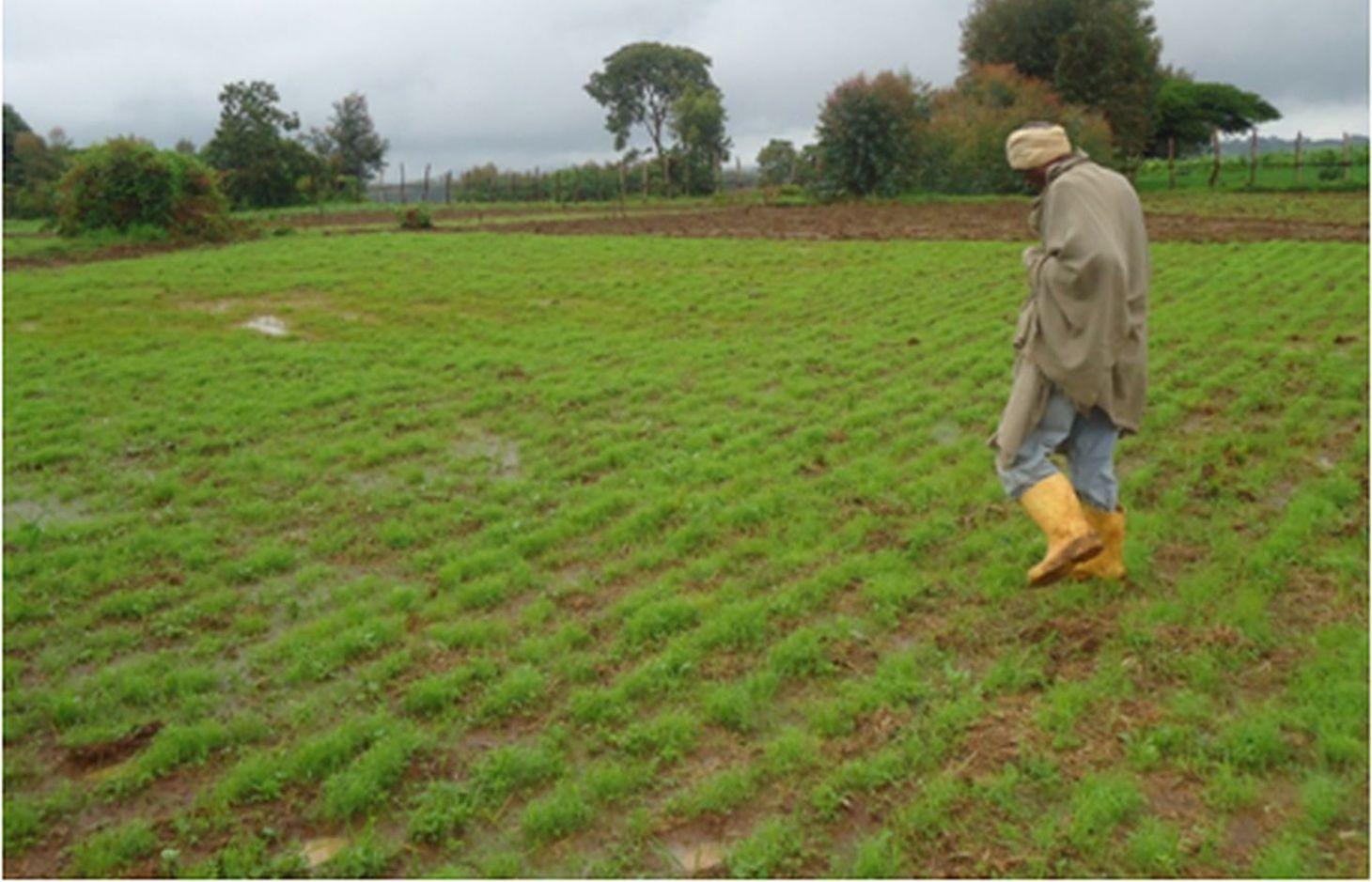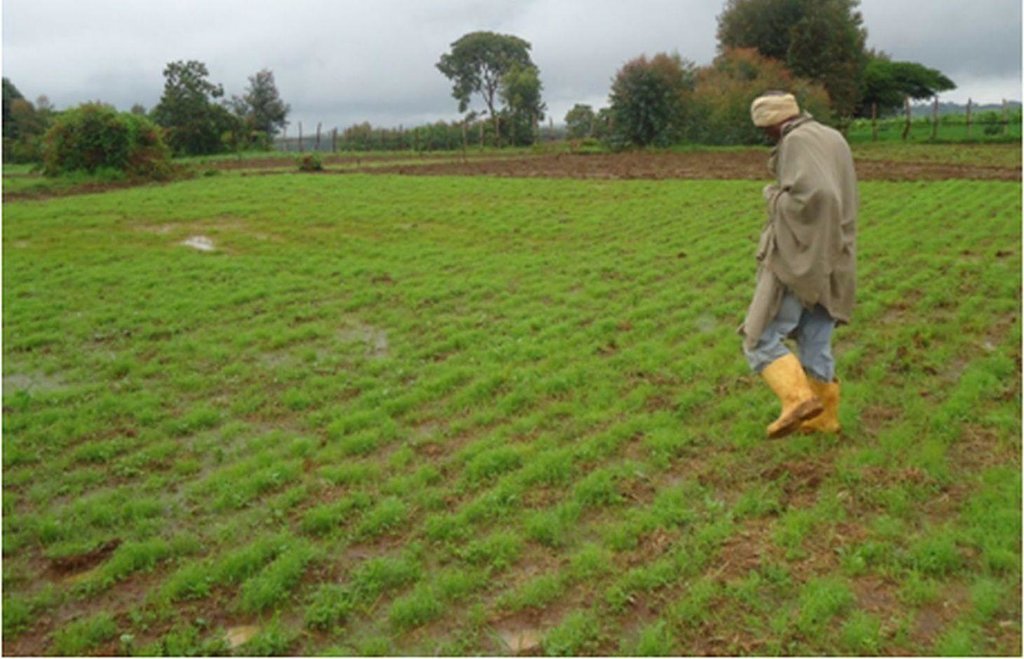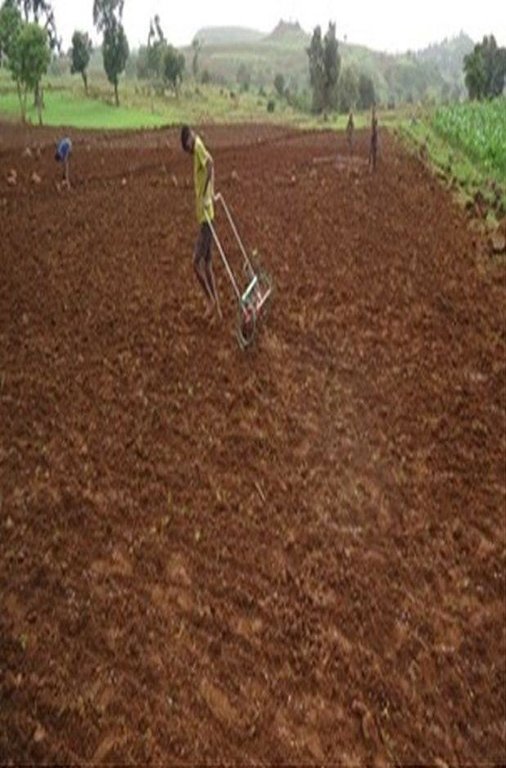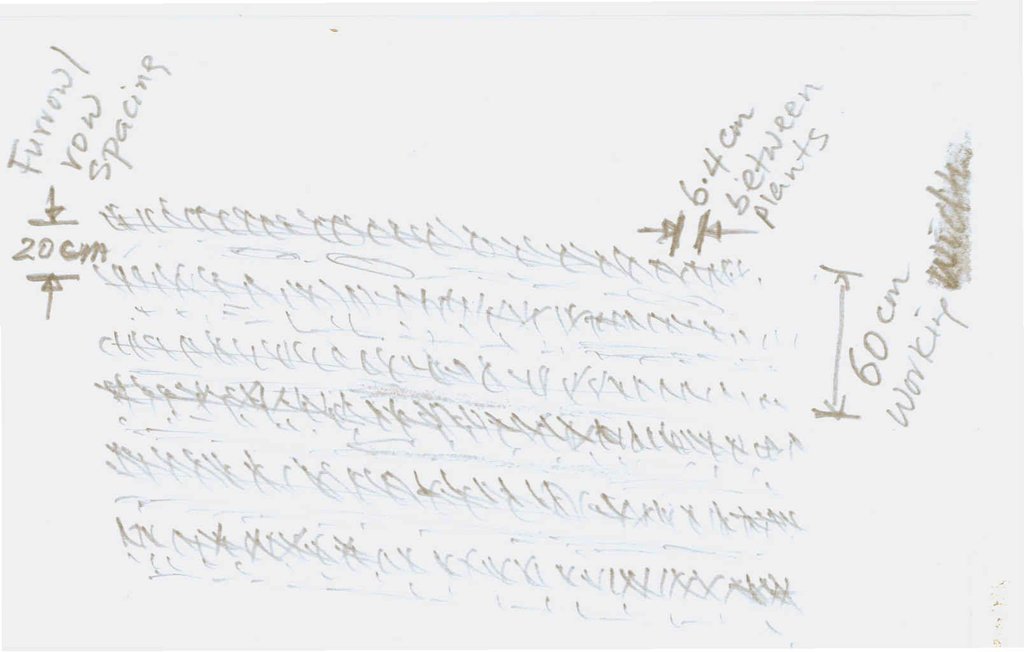Teff row planting [Etiopía]
- Creación:
- Actualización:
- Compilador: Gizaw Desta Gessesse
- Editor: –
- Revisor: Alexandra Gavilano
Teff bemesmr mezrat (Amharic)
technologies_1192 - Etiopía
Visualizar secciones
Expandir todo Colapsar todos1. Información general
1.2 Detalles de contacto de las personas de referencia e instituciones involucradas en la evaluación y la documentación de la Tecnología
Especialista MST:
Tefferra Abu
Bahir Dar Agricultural Mechanization and Food Science Research Centre
Etiopía
Nombre de la(s) institución(es) que facilitaron la documentación/ evaluación de la Tecnología (si fuera relevante)
Water and Land Resource Centre (WLRC) - Etiopía1.3 Condiciones referidas al uso de datos documentados mediante WOCAT
El compilador y la/s persona(s) de referencia claves aceptan las condiciones acerca del uso de los datos documentados mediante WOCAT:
Sí
2. Descripción de la Tecnología MST
2.1 Breve descripción de la Tecnología
Definición de la Tecnología:
Teff row planting is an agronomic practice used to place Teff seeds (very small size) in rows of about 20cm apart and at predetermined depth with sufficient cover of firm soil.
2.2 Descripción detallada de la Tecnología
Descripción:
Teff is a staple crop in Ethiopia and used to make 'Injera'. Teff is commonly planted in broadcast technique with a seed rate of 25-30 kg per hectare. This practice results in high competition for nutrient and water, lodging and low productivity (on average 1 ton/ha). Teff row planting is a newly adopted planting method applied for small size seeds of Teff grain. The row planting technique reduces the seed rate from 25kg/ha to 5-8 kg per hectare, ease the weed management, reduce lodging problem, and lessen plant density and then competition for sunlight, nutrient and water. It is practiced on Teff growing soils except on heavy clay soils or Vertisols where it is difficult to prepare defined rows due to the extreme swelling nature of the soil under near saturation moisture condition. However, under optimum soil moisture (45-50%) it is possible to place seeds in row using manual seed drill in black soils with clay texture. The technique is not perfectly working on stony fields. Seed application is possible using locally available plastic bottles with needle size opening to drop seeds, and newly manufactured seed drill pulled by one person.
Purpose of the Technology: The main purpose to practice Teff row planting is to reduce plant density or population per unit area and thereby increase productivity. It also aim to reduce the lodging problem. Additional advantage of row planting for small grain crop, there is some extent of labor reduction for weeding to some extent.
Establishment / maintenance activities and inputs: Teff row planting technique applies on fine seed bed after 3-5 tillage frequency using local ard plough called maresha pulled by pair of oxen. Once the seed bed is finely prepared, first using local adopted application tools like plastic bottles or hand metering the farmer prepares seed rate of 5-8 kg per hectare mixed with proportional sand (approximately seed to sand ratio of 1:3) - it is difficult to manage uniform application and even distribution by applying the seed alone. He applies along the row and step on to cover the seed and compact it. Similarly, fertilizer is applied in the same way. Second option, after the preparation of fine seed bed, seed application is facilitated using drum type manual seed drill (of weight 21 kg) manufactured by Bahir Dar Agricultural Mechanization and Food Science Research Center (BAMFSRC) having 3 rows of 20cm apart, average depth and width of planting furrow equals to 3.6 cm and 6.4 cm and operating at field capacity of 0.06ha/hr. The drill can apply 3-6 kg/ha seed rate and pulled by one person. At tillering stage urea is top dressed. The technique requires 50-60 person days per hectare to apply seed and fertilizer using hand metering/bottles compared to 2-4 person days per hectare using drum type seed drill. Labor requirement for weeding is also reduced by using row planting than broadcast method.
Natural / human environment: Teff grows on wider environment of altitude range 1800-2600 m above sea level. It performs well with annual rainfall of 750-850 mm and temperature of 10-27 degree Celsius. In fact, there are varieties with short growing period adapted under low rainfall conditions. The row planting technique applies commonly on red clay soils having high water holding capacity. The technique potentially applies on slopes ranging from 0-10% with low stone cover.
Teff row planting using manual seed application or hand metering technique can easily be practiced by households having large family labor. Farm households who used the manual seed drill of drum type should have the capacity to afford the seed drill and able to buy fertilizer. Teff is produced for food and market. It has a good price for sale.
Although teff has high market price in country as well as an emerging export market potential, it is produced annually by subsistence farmers. The land holding is small to meet their family food demands. Their wealth condition ranges poor to average characterized with low agricultural advisory, market and water supply services and inadequate infrastructures. Energy supply is relied on biomass energy. Rural education and health services are improved. Rural unemployment and landless populations are at high rates. In general, the well being of the rural people is under poor condition.
2.3 Fotografías de la Tecnología
Comentarios generales sobre las fotos:
The area covered with Teff row planting referred in this database only considers the area of the pre-scale up activities in the WLRC learning watersheds. The practice is steadily growing over years in teff growing areas of the country in general and Amhara region in particular.
2.5 País/ región/ lugares donde la Tecnología fue aplicada y que se hallan comprendidos por esta evaluación
País:
Etiopía
Región/ Estado/ Provincia:
Amhara
Especifique más el lugar :
Bahir Dar Zuria, Mecha, Yilmana Densa, and Dembecha
Especifique la difusión de la Tecnología:
- distribuida parejamente sobre un área
Si se desconoce el área precisa, indique el área aproximada cubierta:
- 0.1-1 km2
Comentarios:
Boundary points of the Technology area: 10.630850, 37.506877; 11.274962, 37.226641; 11.355705, 37.426134; 11.649907, 37.500604
2.6 Fecha de la implementación
Si no se conoce el año preciso, indique la fecha aproximada:
- hace menos de 10 años (recientemente)
2.7 Introducción de la Tecnología
Especifique cómo se introdujo la Tecnología:
- durante experimentos/ investigación
Comentarios (tipo de proyecto, etc.):
Teff row planting technique was started in research stations 10 to20 years ago. The technique is extended to large number of farmers' field since 2011 through the scale up program of the Ministry of Agriculture. For instance, in 2013 the Amhara region planned to cover 20-30% of teff growing fields.
3. Clasificación de la Tecnología MST
3.2 Tipo(s) actuales de uso de la tierra donde se aplica la Tecnología

Tierras cultivadas
- Cosecha anual
- teff
Número de temporadas de cultivo por año:
- 1
Especifique:
Longest growing period in days: 180Longest growing period from month to month: July to December

Tierra de pastoreo
- Livestock is grazing on crop residues
Comentarios:
Major land use problems (compiler’s opinion): Major land use problems are soil erosion by water, soil nutrient depletion, gully erosion, steep slope cultivation, land fragmentation, and inappropriate runoff drainage practices like drainage ditches on cultivated fields.
Major land use problems (land users’ perception): Land users commonly specify soil erosion by water, shallow soil depth or soil depletion, low productivity of the soil, scarcity of water, and shortage of grazing land or pasture.
3.4 Provisión de agua
Provisión de agua para la tierra donde se aplica la Tecnología:
- mixta de secano – irrigada
3.6 Medidas MST que componen la Tecnología

medidas agronómicas
- A1: vegetación/ cubierta del suelo
Comentarios:
Type of agronomic measures: mineral (inorganic) fertilizers
3.7 Principales tipos de degradación de la tierra encarados con la Tecnología

deterioro físico del suelo
- Pc: compactación
- Pk: desmoronamiento y encostramiento
Comentarios:
Main causes of degradation: soil management (Teff fields are tilled 4-5 times and heavily trampled/compacted by livestock before sowing)
Secondary causes of degradation: Heavy / extreme rainfall (intensity/amounts) (Heavy rainfall cause high runoff and then erosion. It also create sealing effect on the soil surface)
3.8 Prevención, reducción o restauración de la degradación de la tierra
Especifique la meta de la Tecnología con relación a la degradación de la tierra:
- prevenir la degradación de la tierra
- reducir la degradación de la tierra
4. Especificaciones técnicas, actividades de implementación, insumos y costos
4.1 Dibujo técnico de la Tecnología
Especificaciones técnicas (relacionadas al dibujo técnico):
A sketch describing Teff row planting
Location: Aba Gerima, Debre Mewi, Debre Yacob, Gosh Learning. West Gojam/ Amhara Region
Technical knowledge required for field staff / advisors: high (Because of its small seed size, the method requires knowledge of the soil where it performs well and at what depth the seed is placed so that there is high germination and minimizing lodging problem)
Technical knowledge required for land users: high (The land user has to develop capacity and skills on the specific soil and slope conditions where row planting performs well, spacing of rows, depth of furrow and seed quantity per unit area.)
Main technical functions: improvement of surface structure (crusting, sealing), increase of biomass (quantity), Reduction of plant population and competition effect
Secondary technical functions: improvement of topsoil structure (compaction)
Agronomic measure: Row planting
Material/ species: Teff seeds
Quantity/ density: 3-6kg/ha
Remarks: Spacing between rows is 20cm
Mineral (inorganic) fertilizers
Material/ species: Urea and DAP
Quantity/ density: 100 kg/ha
Remarks: for each type of fertilizer
Autor:
Gizaw Desta, WLRC
Fecha:
2014-8-15
4.2 Información general sobre el cálculo de insumos y costos
otra / moneda nacional (especifique):
ETH BIRR
Si fuera relevante, indique la tasa de cambio de dólares americanos a la moneda local (ej. 1 U$ = 79.9 Reales Brasileros): 1 U$ =:
20,0
Indique el costo promedio del salario de trabajo contratado por día:
3.00
4.3 Actividades de establecimiento
| Actividad | Momento (estación) | |
|---|---|---|
| 1. | Drum type row teff seeder (with 3 rows) |
4.4 Costos e insumos necesarios para el establecimiento
| Especifique insumo | Unidad | Cantidad | Costos por unidad | Costos totales por insumo | % de los costos cubiertos por los usuarios de las tierras | |
|---|---|---|---|---|---|---|
| Equipo | machine use | pc | 1,0 | 71,0 | 71,0 | 100,0 |
| Costos totales para establecer la Tecnología | 71,0 | |||||
| Costos totales para establecer la Tecnología en USD | 3,55 | |||||
4.5 Actividades de establecimiento/ recurrentes
| Actividad | Momento/ frequencia | |
|---|---|---|
| 1. | Tillage | Annually after onset of rain, 4-5 times |
| 2. | Seeding | After the soil gets sufficient moisture annually |
| 3. | Weeding | 2-3 times per season |
| 4. | Harvesting | Annually at maturity period (Nov-Dec) |
| 5. | Threshing | Annually during slack period (Dce-Jan) |
| 6. | Transporting and storing grain and straw | Annually during slack period |
4.6 Costos e insumos necesarios para actividades de mantenimiento/ recurrentes (por año)
| Especifique insumo | Unidad | Cantidad | Costos por unidad | Costos totales por insumo | % de los costos cubiertos por los usuarios de las tierras | |
|---|---|---|---|---|---|---|
| Mano de obra | labour | 1,0 | 318,0 | 318,0 | 100,0 | |
| Equipo | animal traction | 1,0 | 266,0 | 266,0 | 100,0 | |
| Material para plantas | seeds | 1,0 | 4,5 | 4,5 | 100,0 | |
| Material para plantas | fertilizer | 1,0 | 150,0 | 150,0 | 100,0 | |
| Indique los costos totales para mantenecer la Tecnología | 738,5 | |||||
| Costos totales para mantener la Tecnología en USD | 36,92 | |||||
Comentarios:
Machinery/ tools: Seed drill, local plough, sickle, hoe
The costs are calculated on hectare basis covered by row planting method. The costs apply for February/March 2014
4.7 Factores más determinantes que afectan los costos:
Describa los factores más determinantes que afectan los costos:
The implementation costs are subject to change due to fluctuation in seasonal labor demand, price of fertilizer, price of iron to construct seed drill, and inflation
5. Entorno natural y humano
5.1 Clima
Lluvia anual
- < 250 mm
- 251-500 mm
- 501-750 mm
- 751-1,000 mm
- 1,001-1,500 mm
- 1,501-2,000 mm
- 2,001-3,000 mm
- 3,001-4,000 mm
- > 4,000 mm
Zona agroclimática
- Sub-húmeda
- semi-árida
Thermal climate class: subtropics
5.2 Topografía
Pendientes en promedio:
- plana (0-2 %)
- ligera (3-5%)
- moderada (6-10%)
- ondulada (11-15%)
- accidentada (16-30%)
- empinada (31-60%)
- muy empinada (>60%)
Formaciones telúricas:
- meseta/ planicies
- cordilleras
- laderas montañosas
- laderas de cerro
- pies de monte
- fondo del valle
Zona altitudinal:
- 0-100 m s.n.m.
- 101-500 m s.n.m.
- 501-1,000 m s.n.m
- 1,001-1,500 m s.n.m
- 1,501-2,000 m s.n.m
- 2,001-2,500 m s.n.m
- 2,501-3,000 m s.n.m
- 3,001-4,000 m s.n.m
- > 4,000 m s.n.m
5.3 Suelos
Profundidad promedio del suelo:
- muy superficial (0-20 cm)
- superficial (21-50 cm)
- moderadamente profunda (51-80 cm)
- profunda (81-120 cm)
- muy profunda (>120 cm)
Textura del suelo (capa arable):
- mediana (limosa)
- fina/ pesada (arcilla)
Materia orgánica de capa arable:
- elevada (>3%)
- media (1-3%)
5.4 Disponibilidad y calidad de agua
Agua subterránea:
> 50 m
Disponibilidad de aguas superficiales:
bueno
Calidad de agua (sin tratar):
solo para uso agrícola (irrigación)
5.5 Biodiversidad
Diversidad de especies:
- baja
5.6 Las características de los usuarios de la tierra que aplican la Tecnología
Orientación del mercado del sistema de producción:
- subsistencia (autoprovisionamiento)
- mixta (subsistencia/ comercial)
Ingresos no agrarios:
- menos del 10% de todos los ingresos
Nivel relativo de riqueza:
- pobre
- promedio
Individuos o grupos:
- individual/ doméstico
Nivel de mecanización:
- trabajo manual
- tracción animal
Género:
- mujeres
- hombres
Indique otras características relevantes de los usuarios de las tierras:
Difference in the involvement of women and men: Women play a role of applying seeds either using locally made plastic bottles or using the manual drum type seed drill to pull. However, men are involved in both in tillage and seeding practices.
Population density: 100-200 persons/km2
Annual population growth: 2% - 3%
5.7 Área promedio de la tierra usada por usuarios de tierra que aplican la Tecnología
- < 0.5 ha
- 0.5-1 ha
- 1-2 ha
- 2-5 ha
- 5-15 ha
- 15-50 ha
- 50-100 ha
- 100-500 ha
- 500-1,000 ha
- 1,000-10,000 ha
- > 10,000 ha
¿Esto se considera de pequeña, mediana o gran escala (refiriéndose al contexto local)?
- pequeña escala
Comentarios:
Average area of land owned or leased by land users applying the Technology: < 0.5 ha, 0.5-1 ha, 1-2 ha
5.8 Tenencia de tierra, uso de tierra y derechos de uso de agua
Tenencia de tierra:
- estado
- individual, con título
Derechos de uso de agua:
- acceso abierto (no organizado)
5.9 Acceso a servicios e infraestructura
salud:
- pobre
- moderado
- bueno
educación:
- pobre
- moderado
- bueno
asistencia técnica:
- pobre
- moderado
- bueno
empleo (ej. fuera de la granja):
- pobre
- moderado
- bueno
mercados:
- pobre
- moderado
- bueno
energía:
- pobre
- moderado
- bueno
caminos y transporte:
- pobre
- moderado
- bueno
agua potable y saneamiento:
- pobre
- moderado
- bueno
servicios financieros:
- pobre
- moderado
- bueno
6. Impactos y comentarios para concluir
6.1 Impactos in situ demostrados por la Tecnología
Impactos socioeconómicos
Producción
producción de cultivo
Cantidad antes de MST:
1.2 ton/ha
Cantidad luego de MST:
>2.7 ton/ha
producción de forraje
Cantidad antes de MST:
2.4 ton/ha
Cantidad luego de MST:
5 ton/ha
calidad de forraje
producción animal
Ingreso y costos
ingreso agrario
Impactos socioculturales
seguridad alimentaria/ autosuficiencia
Improved teff agronomic knowledge
Impactos ecológicos
Ciclo de agua/ escurrimiento de sedimento
escurrimiento superficial
Suelo
humedad del suelo
encostramiento/ sellado de suelo
compactación de suelo
Biodiversidad: vegetación, animales
control de pestes/ enfermedades
6.3 Exposición y sensibilidad de la Tecnología al cambio climático gradual y a extremos relacionados al clima/ desastres (desde la percepción de los usuarios de tierras)
Extremos (desastres) relacionados al clima
Desastres climatológicos:
| ¿Cómo es que la tecnología soporta esto? | |
|---|---|
| tormenta de lluvia local | no muy bien |
Desastres climatológicos
| ¿Cómo es que la tecnología soporta esto? | |
|---|---|
| sequía | no muy bien |
Otras consecuencias relacionadas al clima
Otras consecuencias relacionadas al clima
| ¿Cómo es que la tecnología soporta esto? | |
|---|---|
| periodo reducido de crecimiento | no muy bien |
6.4 Análisis costo-beneficio
¿Cómo se comparan los beneficios con los costos de establecimiento (desde la perspectiva de los usuarios de tierra)?
Ingresos a corto plazo:
positivo
Ingresos a largo plazo:
muy positivo
¿Cómo se comparan los beneficios con los costos de mantenimiento/ recurrentes (desde la perspectiva de los usuarios de tierra)?
Ingresos a corto plazo:
ligeramente positivo
Ingresos a largo plazo:
positivo
Comentarios:
Since the new technology (Teff row planting) requires high human labor while placing seeds using hand metering or plastic bottles (locally adopted) to apply the seeds, the land users perceived that the cost of labor is high and can not be affordable using family labor alone. Until they developed experience the return may be considered as slightly positive. However, if the land users adopt to use the manual drum type seed drill the return is very positive and positive as compared to the establishment and recurrent costs, respectively.
6.5 Adopción de la Tecnología
Comentarios:
There is a moderate trend towards spontaneous adoption of the Technology
Comments on adoption trend: The adoption is growing with extensive technical guidance and push from the research and extension services.
6.7 Fuerzas/ ventajas/ oportunidades de la Tecnología
| Fuerzas/ ventajas/ oportunidades desde la perspectiva del usuario de la tierra |
|---|
|
There is yield advantage both grain and straw How can they be sustained / enhanced? The technique needs an improved tool to reduce labor demand. It has to be supported with improved varieties and agronomic practices |
| It requires small amount of seed |
| According to some farmers it avoids the usual practice called trampling of seed bed by livestock after sowing the seed |
| Fuerzas/ ventajas/ oportunidades desde la perspectiva del compilador o de otra persona de referencia clave |
|---|
|
Teff row planting can bring 30-50% yield advantage compared to the broadcasting method of planting How can they be sustained / enhanced? The yield advantage can be sustained by using an integrated or package of Teff production technologies such as improved teff varieties, recommended fertilizer, pesticides and weeding |
|
It reduces three to four times the amount of seed required using the broadcasting method How can they be sustained / enhanced? This advantage can be enhanced or continue to sustain by using an improved low cost seed drills |
|
The technology eases the weeding practice without damaging the plants How can they be sustained / enhanced? Appropriate low cost weeders or herbicides can be used to further enhance the technique |
|
The technology reduces damage due to lodging problem along with the use of selected Teff varieties having strong stem How can they be sustained / enhanced? This can be sustained if supported with further research in the depth of seed placement and genetic improvement |
6.8 Debilidades/ desventajas/ riesgos de la Tecnología y formas de sobreponerse a ellos
| Debilidades/ desventajas/ riesgos desde la perspectiva del usuario de la tierra | ¿Cómo sobreponerse a ellas? |
|---|---|
| The implement has relatively low stability to make straight rows. | Improving the workmanship will solve the problem |
| Non uniform seed application if pulling speed not constant | Proper seed bed preparation and removal of stones will solve the problem |
| Debilidades/ desventajas/ riesgos desde la perspectiva del compilador o de otra persona de referencia clave | ¿Cómo sobreponerse a ellas? |
|---|---|
| Uniform application and distribution of small amount of seed (as low as 5kg) in rows of 20cm apart become challenging compared to the broadcasting technique | This can be overcome by continuous skill development through practice and training |
| The small number of plant populations or vigorous growth of teff plants favor the shoot fly damage. | Application of chemicals will control shootfly |
7. Referencias y vínculos
7.1 Métodos/ fuentes de información
7.2 Vínculos a las publicaciones disponibles
Título, autor, año, ISBN:
(Unpublished Report, 2013): Technical Evaluation and Selection of Suitable Teff Seed Drill in Amhara Region, by team of Researchers in ARARI, Bahir Dar Mechanization and Food Science research Center and Lecturers from Bahir Dar University
Título, autor, año, ISBN:
Dereje Gorfu and Eshetu Ahmed (unpublished). Crops and Agro-ecological Zones of Ethiopia. Ethiopian Institute of Agricultural Research
Título, autor, año, ISBN:
http://www.worldbank.org/html/cgiar/newsletter/Sept97/10tef.html
Vínculos y módulos
Expandir todo Colapsar todosVínculos
No hay vínculos
Módulos
No se hallaron módulos





